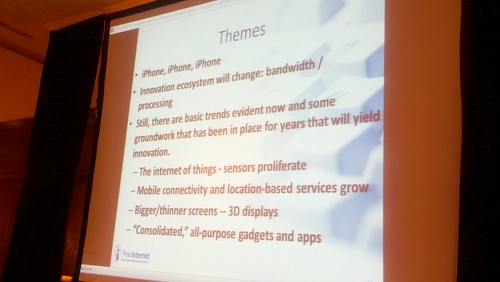
Lee Raine was today's keynote speaker. Video of the presentation and his slides are here.
Here are my notes from the session, mostly based on my tweets.
The phrase "new normal" was mentioned as a part of this talk. For me, this is not new, it is my normal. I've been engaged in social networking and participated in my community as an embedded librarian. The learning communities idea is very much a part of the knowledge commons concept. While much of this is a no-brainer in my mind, it is a good reminder that there are still a lot of librarians and educational professionals for whom these ways of thinking are new.
5 questions for librarians as they ponder learning communities:
Volume, velocity, and valence/relevance.
- Future of knowledge?
- Reference expertise?
- Public technology?
- Learning spaces?
- Community anchor institutions?
65% Internet users are on social networking sites, 13% using Twitter. This sharing is content creation story.
84% of people use mobile phones.
Importance of PEW data for librarians is we have to serve all users and the digital divides are real (my interpretation)
Social networks are more influential and differently segmented and layered.
Librarians as nodes in people's networks. Libraries as anchor institutions.
Cited Shanna Ratner (1997) Emerging Issues in Learning Communities.
Embedded librarian model: librarian as scout for relevant material, reviewer and synthesizer, organizer and taxonomy creator, on-call for just in time information.
Librarian as teacher of social media.
Librarians will be asked to recommend what analytics work, increased role with regards to "big data".
For the second day in a row, I decided to stick with Track D: Tools of Engagement facilitated by Jim Tchobanoff.
Track D: Collaborating: Students & Librarians.
Michelle Jacobs, Pepperdine University, had a high energy presentation chock full of information. Highlights from her session:
- Go where students are to find out what they need for their complete educational experience. Jacobs would attend student group meetings to learn from and about her students.
- They implemented a study room reservation system software as a result of student interest.
- A Library Ambassadors program was put in place for peer to peer general assistance and service triage (reference, IT, etc.). Also used Library Ambassador to help decide where you really need signs. They're students so they know!
- Student generated LibGuides: students gave feedback on what they felt would be most helpful.
- Captive library audience in the bathroom = opportunity to install newsletter with useful student focused information.
- Pop up lounge concept: students proposed ways to create new student spaces with flexible non-traditional furniture.
- "Research support: more than reference."
- Use google style beta to assess how new configuration for academic excellence area.
- Collaboration with units on campus also means getting students involved to teach skills. For example, students wanted to teach a class on a particular software functionality (creating colorful tables and graphs, working with images to create slides, etc.). Allow students to be expert and share their knowledge.
Lisa Kurtz, University of Nevada-Reno presented on the @One project. They borrowed the Apple model for this project because they "design experiences". Developed @eReader Bar and a LibGuide based on their eReader experience. The project launched in April 2011.
Track D: Repositioning with Tablets, Social Media, & Outreach
Tim Donahue, Montana State University offered an interesting presentation on tablets in libraries.
- Tablets as combo of personal computer and smartphone.
- Donahue notes he did not find a standard definition "what is a tablet".
- Tablets employ new technologies, are app culture driven, and have a non-textual thrust.
- "You don't need language to use a tablet."
- Implications for libraries?
- Ownership by our users will likely increase.
- Size may also increase popularity.
- Tablets interface better with mobile information (QR codes).
- Do libraries need to develop tablet-specific web sites? Mobile versions aren't always the solution.
- Are databases, online catalogs, and other popular library resources going to take advantage of tablet features such as rotating screen to move through results?
Arlene Keller, Multnomah County Library talked about "Using Facebook for your library." Her main points included
- You want your patrons to engage with you where they spend the most time online.
- Must monitor your Facebook wall for spam. The spam is not always negative information.
- All posts from the library should be on topic and match library mission.
- The Facebook fan place is a growing space to provide readers advisory to your community.
No comments:
Post a Comment